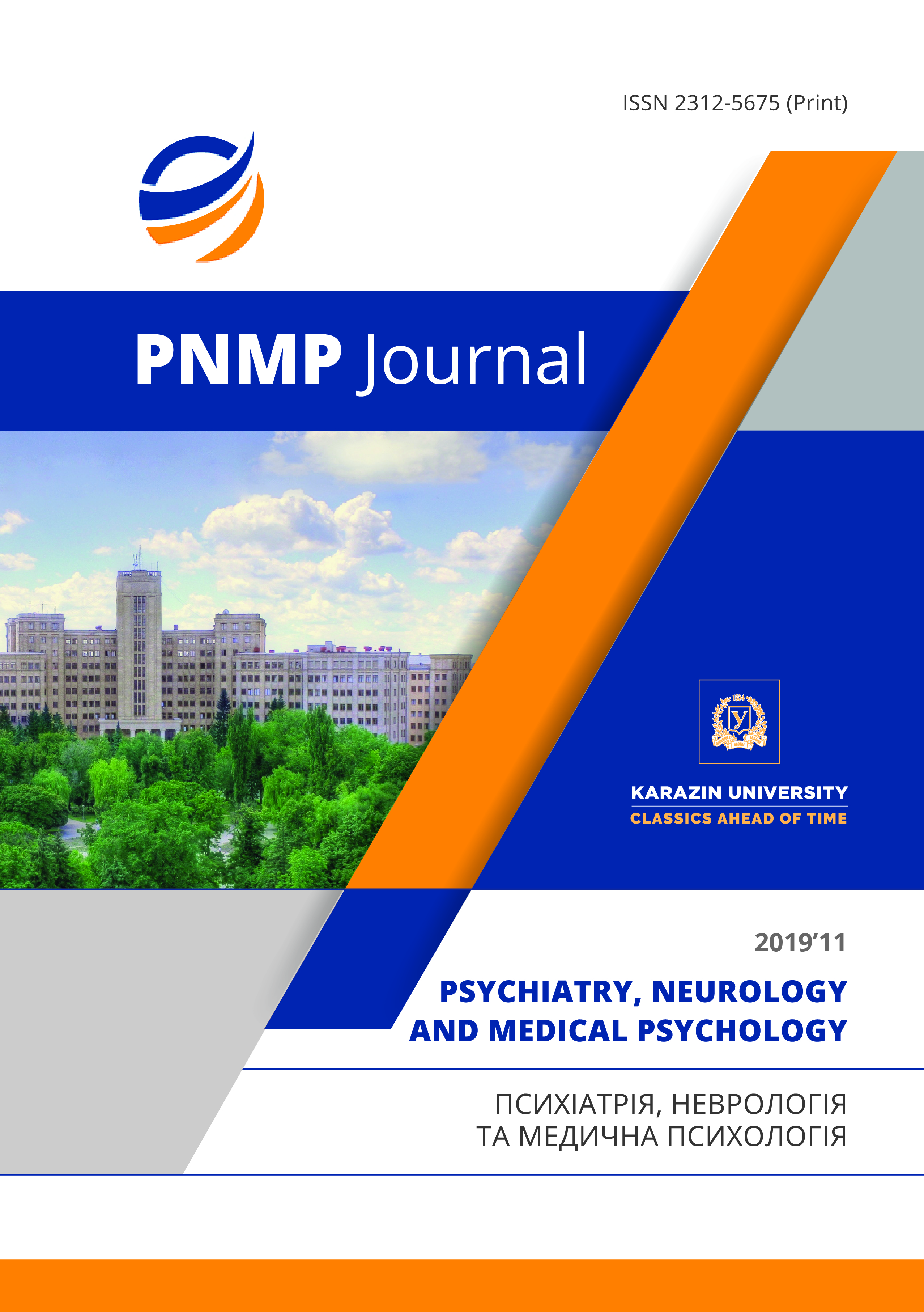Correction of auto-aggressive trends as a link to the psychoneurological model of adaptation of patients with demyelinizing pathology
Abstract
In this article, we analyzed current data on autoaggression in patients with demyelinating pathology. We noted that the issues of neuropsychiatric adaptation and rehabilitation of patients with demyelinating pathology remain acutely relevant to date. An important place in the package of measures for the early detection of disorders in the emotional sphere is occupied by studies of aggression, in particular, unconscious aggression, which under certain conditions can acquire an autoaggressive orientation. It has been established that there is no information on the severity of unconscious aggression in patients with multiple sclerosis of the Ukrainian population, which are important for identifying targets for the prevention of suicidal activity. The article presents the results of the “Hand-test” method for residents of the Eastern region of Ukraine with a remitting type of multiple sclerosis (RT MS) who were treated at the Institute of Neurology, Psychiatry and Narcology of the National Academy of Medical Sciences of Ukraine (n = 71). The study was carried out in connection with the task of improving the neuropsychiatric model of adaptation and rehabilitation of patients based on the early identification of autoagression prevention targets. The tendency to aggressive behavior was assessed by comparing the trends reflecting the readiness for aggressive behavior, as well as the trends that suggest cooperation. We have identified difficulties in the field of social contacts, which can find expression in being fenced off from others and formalism in relationships. We have identified such a psychodiagnostic profile in which, against the background of increased unconscious aggression, indicators of dependence and personality immaturity dominate. This combination carries a potential threat to the realization of an auto-aggressive trend. The study, which was conducted, revealed a general increased tendency to manifest aggressiveness in the examined patients. Patients intensely felt a sense of dependence, helplessness, subordination, and at the same time did not realize their aggression; this was identified by us as a target of prevention of potential suicidal activity. The study, identification and further correction of unconscious behavioral trends is an important part of the neuropsychiatric model of adaptation of patients with demyelinating pathology.
Downloads
References
Terenteva I. Yu. [Features of personality adaptation in patients with multiple sclerosis]: dissertatsiya ... kand. med. nauk : 19.00.04, Sankt-Peterburg, 2005, 115 p. [In Russ.]
Bronnum-Hansen H., Stenager Е., Nylev Stenager E. [et al.] Suicide among Danes with multiple sclerosis. J. Neurol. Neurosurg Psychiatry, 2005, no.76. pp.1457-1459.
Kutsenko N.I. [Suicidal behavior of patients with multiple sclerosis (clinical-dynamic and socio-psychological aspects)]: dissertatsiya ... kand. med. nauk : 14.00.18; [Mesto zaschityi: GU "Nauchno-issledovatelskiy institut psihicheskogo zdorovya Tomskogo nauchnogo tsentra Sibirskogo otdeleniya RAMN"], Tomsk, 2008, 138p. [In Russ.]
Zotov P.B., Kutsenko N.I., Umanskiy S.M. [Psychopathological factors of the antisuicidal barrier (on the example of patients with multiple sclerosis)]. Meditsinskaya nauka i obrazovanie Urala, 2008, no. 6, pp. 46-47. [In Russ.]
Zotov P.B., Kutsenko N.I. [Motives for suicidal activity and anti-suicidal barrier factors in patients with multiple sclerosis]. Suitsidologiya, 2011, no. 3, pp. 20-25. [In Russ.]
Stenager E.N., Stenager E., Koch-Henriksen N. [et al.] Suicide and multiple sclerosis: an epidemiological investigation. J. Neurol. Neurosurg. Psychiatry, 1992, Vol. 55, pp. 542-545.
Turner A.P., Williams R.M., Bowen J.D. [et al.] Suicidal ideation in multiple sclerosis. Arch. Phys. Med. Rehabil., 2006, Vol 87, pp. 1073-1078.
Shen Q. , Lu H., Xie D. [et al.] Association between suicide and multiple sclerosis: An updated meta-analysis. Multiple Scler. J., 2019, Vol.34, pp. 83-90.
Marrie R.A. What is the risk of suicide in multiple sclerosis? Multiple Scler. J., 2017, Vol.23, pp. 755-756.
Kurbatova T.N., Mulyar O.I. [The projective method of personality research “Hand-test”: a methodological guide]. SPb.: IPP IMATON, 2001, 64 p. [In Russ.]
Vagner E. Test ruki (Hand Test). Psihologicheskaya entsiklopediya [Hand Test. Psychological Encyclopedia], pod red. R. Korsini, A. Auerbaha, 2-e izd., SPb.: Piter, 2006, 1096 p. [In Russ.]
Hrulenko-Varnitskiy I.O. [About some methodological approaches to the assessment of emotional excitability in the process of pharmacotherapy of patients with borderline mental disorders]. Farmateka, 2012, no. 3, pp. 31-36. [In Russ.]
Reznikova T.N., Seliverstova N.A. [On the meaning of conscious and unconscious emotional processes in multiple sclerosis]. Vestnik Severo-Zapadnogo gosudarstvennogo meditsinskogo universiteta im. I.I. Mechnikova., 2017, tom 9, vol. 3, pp. 53-58. [In Russ.]
Shamova T.M., Karpovich-Misnik A.V. [Characteristics of the personality of patients with multiple sclerosis according to the projective method "Hand-test"]. Zhurnal GrGMU, 2007, vol. 4, pp. 80-82. [In Russ.]
Reznikova T.N., Seliverstova N.A., Kataeva G.V. [i dr.]. [Functional activity of brain structures and a tendency to aggression in patients with long-term central nervous system diseases]. Fiziologiya cheloveka, 2015, Tom 41, vol. 1, pp. 35-42. [In Russ.]
Bulyigina V.G., Kotova T.A., Kotova M.A. [i dr.]. [Psychodiagnostic research methods in the practice of compulsory treatment of mentally ill]. M.: FGBU «GNTs SSP im. V.P. Serbskogo», 2010, 302 p. [In Russ.]
Makushkin E.V., Gorinov V.V. [Motivational aggression]. Rossiyskiy psihiatricheskiy zhurnal, 2016, vol.2, pp. 11–19. [In Russ.]
Polman C.H., Reingold S.C., Banwell B. [et al.] Diagnostic criteria for multiple sclerosis: 2010 revisions to the McDonald criteria. Ann. Neurol., 2011, Vol. 69, no. 2, pp. 292-302.
Kurtzke J. F. Rating neurologic impairment in multiple sclerosis: an expanded disability status scale (EDSS). Neurology, 1983, Vol. 33, no. 11, pp. 1444-1452.
Xmilyar O.F. [ Symbolic hand language and human behavioral tendencies]. Naukovi zapy`sky`. Seriya «Psy`xologiya i pedagogika», 2012, Vol.19, pp. 254-258. [In Ukr.]




